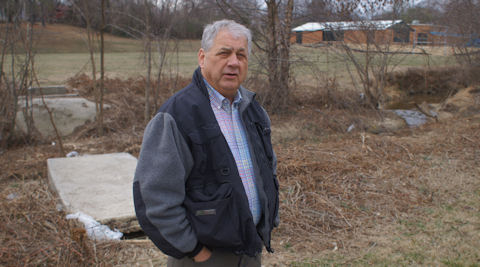
The Bellemeade Walkable Watershed project aims to reclaim a damaged creek, create a route for kids to walk to school, and boost community spirit in a gritty, inner-city Richmond neighborhood.
by James A. Bacon
Bob Argabright got involved with Richmond city schools nine years ago when he volunteered to help two young students learn to read. It wasn’t long before he discovered that the challenges faced by inner city kids run far deeper than a difficulty with letters and words. As he delved deeper into their lives and their surroundings, his volunteer activity became a full-time vocation. Today, the retired paper industry executive is such a fixture at Oak Grove-Bellemeade Elementary School that children wave to him in the hall, call him by name and even run up to give him a hug.
“I think it’s totally unfair for a child to be born in the 23229 zip code and be set for life while a child born in 23224 has a low probability of success,” says Argabright. “Ninety percent of our kids say they want to be a rap star, an NFL football player or a beautician. We’re trying to show them other paths. … We’re teaching these children to dream.”
As unlikely as it might sound, Argabright is hoping that a few children might conceive the ambition of becoming an architect or an environmental engineer.
Making that connection would have been unlikely a year ago, when the students at Oak Grove-Bellemeade were attending the old Bellemeade Elementary School, an aged and decrepit school building that screamed urban blight. But this month they moved into a new, LEED-standard school building next door that is fresh, clean and airy. Every section of the school bears a name associated with the James River — the river bed, forest floor, forest canopy, and the like — to serve as inspiration for teaching about nature. Moreover, the city is moving forward with a project to restore the severely eroded creek behind the school with the aim of creating a community resource and a focus for environmental education.
The Bellemeade Walkable Watershed is a triumph of public-private collaboration, says Michelle Virts, deputy director of utilities. “It’s a great opportunity for the city to stretch our dollars.” The project is funded largely through a $187,000 National Fish & Wildlife grant to restore the creek, and a $60,000 Environmental Protection Agency grant to build a watershed coalition, but the city is chipping in land, public works money and staff time, while not-for-profits like the James River Association and the Alliance for the Chesapeake Bay are providing volunteers for clean-up and money for tree planting.
Perhaps the most intriguing aspect of the walkable watershed is how the community is leveraging a single project to advance multiple goals: stream restoration, environmental education, a community garden and a network of sidewalks and trails. By making it possible for hundreds of kids, many of whom live in housing projects, to walk or bicycle to school instead of ride the bus, the project, it is hoped, will ward off the obesity that plagues Richmond’s inner city.
Many educators, public officials and not-for-profits have contributed to the project. But Argabright is the thread tying the efforts together. “Bob is extremely active in the neighborhood,” says Virts. “He makes things happen.”
“Bob Argabright is totally on fire about this thing,” says Champe Burnley, president of the Virginia Bicycling Federation, who recalls meeting with him more than half a year ago. Argabright was thinking ahead to when the new route opens for children to walk and bike to school. How many poor kids own bicycles? Not many. Even back then, he was working the angles to rustle up some used bikes. He now has 300 (only some of which, he regrets, are suitable for children) sitting in a warehouse in anticipation of the day when they can be used.
Argabright is not one to claim credit. He sings the praises of everyone involved in the project, from Oak Grove-Bellemeade’s principle Jannie Laursen to Lara Kling with the Blue Sky Fund, which has raised $275,000 to fund outdoor nature programs for inner city schools, including Oak Grove-Bellemeade. He depicts his contribution mainly as showing up at community events, pushing to get things done and building a web of contacts linking corporate leaders with City Hall and neighborhood volunteers and activists. Says he: “What I’m doing is networking, doing what I’ve done my whole career.”
Re-greening Richmond
Two developments were key to making the project happen. One was construction of the Oak Grove-Bellemeade School, which opened its doors this year. Children from the old Bellemeade School, located right next door, moved in right away. Students from Oak Grove will transfer next school year. The 90,000-square-foot facility is state-of-the-art. But it’s one thing to teach a subject like science in the abstract to inner-school children who have seldom ventured outside their concrete-and-asphalt domain, and quite another to teach them in a natural environment. More.


